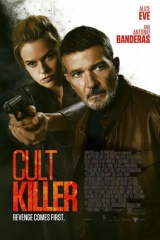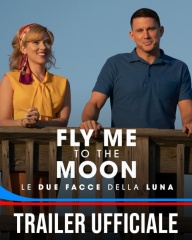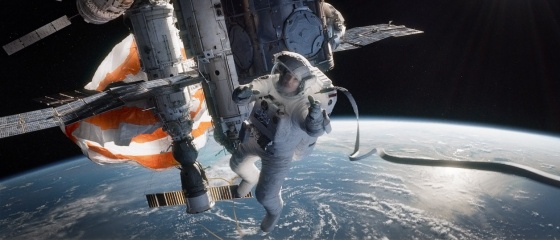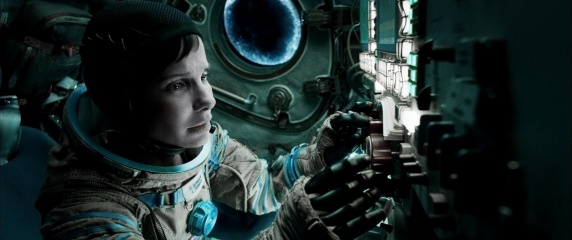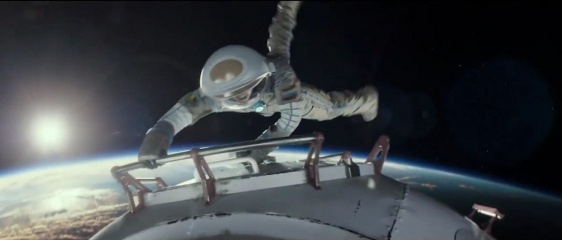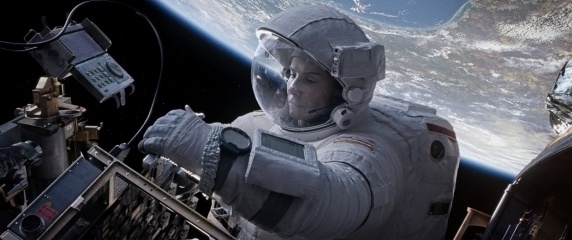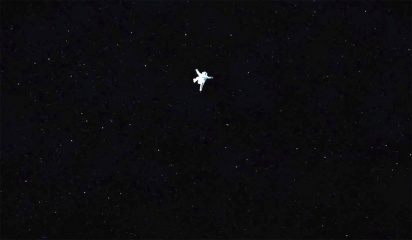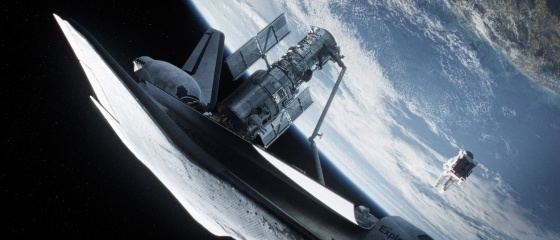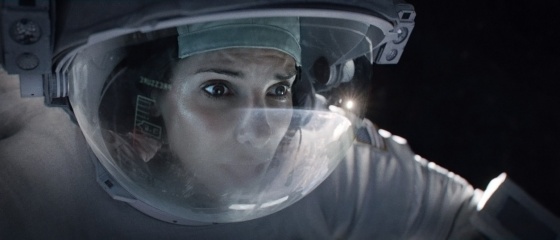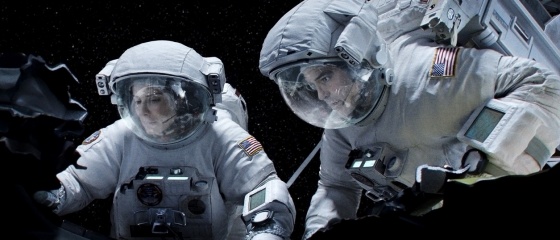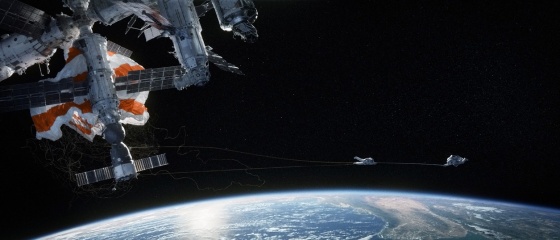|
|
GRAVITY: A DISTANZA DI DIECI ANNI DA 'SOLARIS' GEORGE CLOONEY TORNA NELLO SPAZIO IN VESTE DI ASTRONAUTA VETERANO AL SUO ULTIMO VOLO PRIMA DEL RITIRO, QUESTA VOLTA PER AFFIANCARE L'INGEGNERE MEDICO SANDRA BULLOCK, ALLA SUA PRIMA MISSIONE SPAZIALE
VINCITORE di 7 PREMI OSCAR 2014 (tra cui 'MIGLIOR REGIA' per ALFONSO CUARON) - RECENSIONE ITALIANA IN ANTEPRIMA e PREVIEW in ENGLISH by JUSTIN CHANG (www.variety.com) -70. Mostra Internazionale dâArte Cinematografica (28 agosto â 7 settembre 2013) - FILM di APERTURA Fuori Concorso - Dal 3 OTTOBRE
"La sindrome Kessler è unâipotesi formulata dagli scienziati della NASA: la densità di oggetti creati dallâuomo che circolano nella bassa orbita terrestre è così alta che se due oggetti si scontrassero ne deriverebbe una cascata di rottami che andrebbe a urtare altri oggetti e ogni collisione genererebbe nuovi rottami spaziali. Abbiamo utilizzato questa teoria come metafora per le avversità della vita. Il nostro personaggio scivola nel vuoto, tentando di superare la sua stessa inerzia per fare ritorno sulla Terra dove lâattende qualcosa che sta oltre la sopravvivenza: la possibilità di rinascere".
Il regista Alfonso Cuarón
(Gravity; USA 2012; Thriller Sci-Fi; 90'; Produz.: Reality Media/Warner Bros. Pictures; Distribuz.: Warner Bros. Pictures Italia)
 SEE SHORT SYNOPSIS
SEE SHORT SYNOPSIS
|
Titolo in italiano: Gravity
Titolo in lingua originale:
Gravity
Anno di produzione:
2012
Anno di uscita:
2013
Regia: Alfonso Cuarón
Sceneggiatura:
Alfonso e Jonás Cuarón, Rodrigo GarcÃa
Cast: George Clooney (Matt Kowalski)
Sandra Bullock (Ryan Stone)
Ed Harris (Controllo Missione) (Voce)
Orto Ignatiussen (Aningaaq) (Voce)
Phaldut Sharma (Shariff) (Voce)
Amy Warren (Capitano Explorer) (Voce)
Basher Savage (Capitano stazione spaziale russa) (Voce)
Musica: Steven Price
Costumi: Jany Temime
Scenografia: Andy Nicholson
Fotografia: Emmanuel Lubezki
Montaggio: Alfonso Cuarón e Mark Sanger
Effetti Speciali: Neil Corbould e Manex Efrem (supervisori effetti speciali); Tim Webber e Chris Watts (supervisori effetti visivi)
Makeup: Pamela S. Westmore (per Sandra Bullock)
Casting: Richard Hicks e David Rubin
Scheda film aggiornata al:
04 Marzo 2014
|
Sinossi:
IN BREVE:
L'unico sopravvisuto di un missione spaziale per la riparazione del telescopio Hubble tenta disperatamente di tornare sulla Terra per potersi riunire con sua figlia.
IN DETTAGLIO:
Sandra Bullock è la brillante dottoressa Ryan Stone, alla sua prima missione a bordo dello shuttle, mentre George Clooney è Matt Kovalsky, un astronauta esperto al suo ultimo volo prima della pensione. Ma quella che sembrava una normale passeggiata nello spazio si trasforma in una catastrofe e lo shuttle viene distrutto, lasciando Stone e Kowalsky completamente soli - collegati solo fra loro e fluttuanti nellâoscurità . Il silenzio assordante in cui sono immersi significa che hanno perso ogni contatto con la Terra⦠e ogni speranza di salvezza. Quando la paura si trasforma in panico, ogni sorsata dâaria riduce il poco ossigeno rimasto. Ma forse lâunico modo per tornare a casa è addentrarsi in quel terribile spazio infinito.
SHORT SYNOPSIS:
The lone survivor of a space mission to repair the Hubble telescope desperately tries to return to Earth and reunite with her daughter.
Commento critico (a cura di PATRIZIA FERRETTI)
|
 Film dalla doppia anima: per certi versi (effetti e riprese) superbo e persino spiazzante da brivido, dal tocco Kubrickiano, per altri (soprattutto nella seconda parte) ampiamente hollywoodiano con l'aggiunta di disturbanti tocchi mèlo (musica e sceneggiatura) intessuta ad una scarsa credibilità esibita in molti passaggi nelle varie operazioni di sopravvivenza a go-go. Così il Cuaròn metafisico-esistenzialista sull'onda della metafora - le tempeste di detriti spaziali a raffica e le forti presenze emotive a supporto psicologico in grado di materializzarsi in carne ed ossa - sembra quasi tirarsi indietro per cedere il passo all'umorismo di Clooney (Matt) e all'eroina spaziale Bullock (Ryan) che, tra una grandinata di missioni impossibili nella missione impossibile, si guadagna il traguardo di un finale prevedibile per non dire scontato!
Film dalla doppia anima: per certi versi (effetti e riprese) superbo e persino spiazzante da brivido, dal tocco Kubrickiano, per altri (soprattutto nella seconda parte) ampiamente hollywoodiano con l'aggiunta di disturbanti tocchi mèlo (musica e sceneggiatura) intessuta ad una scarsa credibilità esibita in molti passaggi nelle varie operazioni di sopravvivenza a go-go. Così il Cuaròn metafisico-esistenzialista sull'onda della metafora - le tempeste di detriti spaziali a raffica e le forti presenze emotive a supporto psicologico in grado di materializzarsi in carne ed ossa - sembra quasi tirarsi indietro per cedere il passo all'umorismo di Clooney (Matt) e all'eroina spaziale Bullock (Ryan) che, tra una grandinata di missioni impossibili nella missione impossibile, si guadagna il traguardo di un finale prevedibile per non dire scontato!
Stanley Kubrick forse non avrebbe mai iniziato un suo film con una lunga didascalia esplicativa del fatto che 600km sopra il pianeta Terra, per gli effetti dell'assenza di |
|
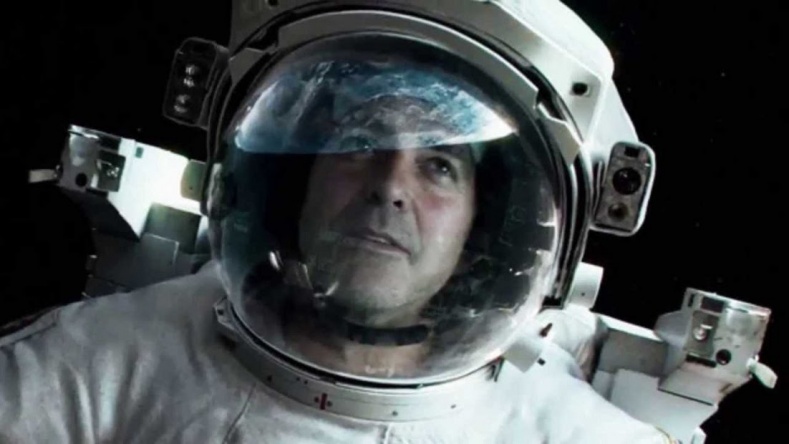 gravità , dunque di peso, "la vita nello spazio è impossibile", ma non avrebbe d'altra parte potuto fare - anche per scarsità di mezzi tecnici all'epoca - quanto Alfonso Cuaron (I figli degli uomini) è riuscito a fare in Gravity riguardo alla resa in dettaglio di scorci panoramici nelle profondità spaziali, congiunta con il caleidoscopio di dinamiche di reattività fisica dei corpi. Anche il contraccolpo tra il motivo musicale altisonante dell'inizio e il silenzio totale in pieno spazio, infranto molto gradualmente dalle prime intermittenti comunicazioni via radio emergenti in sottofondo, pur non del tutto inedito, esprime incomparabile bellezza ed elegante equilibrio ad un tempo, toccando un pò più in avanti momenti estatici notevoli, anche al di là dell'evidente contributo del 3D. E' sufficiente la sequenza dell'aurora a farci parlare di vera arte, concentrata in un fotogramma equivalente ad una video-installazione di arte contemporanea di altissimo livello. Un'arte che diventa il respiro
gravità , dunque di peso, "la vita nello spazio è impossibile", ma non avrebbe d'altra parte potuto fare - anche per scarsità di mezzi tecnici all'epoca - quanto Alfonso Cuaron (I figli degli uomini) è riuscito a fare in Gravity riguardo alla resa in dettaglio di scorci panoramici nelle profondità spaziali, congiunta con il caleidoscopio di dinamiche di reattività fisica dei corpi. Anche il contraccolpo tra il motivo musicale altisonante dell'inizio e il silenzio totale in pieno spazio, infranto molto gradualmente dalle prime intermittenti comunicazioni via radio emergenti in sottofondo, pur non del tutto inedito, esprime incomparabile bellezza ed elegante equilibrio ad un tempo, toccando un pò più in avanti momenti estatici notevoli, anche al di là dell'evidente contributo del 3D. E' sufficiente la sequenza dell'aurora a farci parlare di vera arte, concentrata in un fotogramma equivalente ad una video-installazione di arte contemporanea di altissimo livello. Un'arte che diventa il respiro |
|
 vitale della parabola metaforico-esistenzialista che decolla con discrezione, planando con tutte le turbolenze del caso, prima di atterrare sulla limacciosa spiaggia di una rinascita possibile.
vitale della parabola metaforico-esistenzialista che decolla con discrezione, planando con tutte le turbolenze del caso, prima di atterrare sulla limacciosa spiaggia di una rinascita possibile.
Del resto, fuor di metafora, la banalità regnerebbe sovrana (anche se non prima di raggiungere la seconda parte del film) al punto da far collassare questa pellicola ibrida, dalle due anime: la prima metafisico-esistenziale che poggia su un discernimento scientifico e che sa attardarsi con infinita leggiadria, affascinando su scorci di ambientazione inediti con un buon grado di interazione dei due personaggi chiave, il veterano astronauta Matt Kowalsky/George Clooney e l'ingegnere biomedico Ryan Stone/Sandra Bullock. Interazione assolutamente credibile anche sull'onda delle spruzzatine di humour rilasciate da Clooney dalle maglie di una buona base di sceneggiatura (Alfonso e Jonàs Cuaron). Nella seconda anima, per così dire, della medesima pellicola, persino le sottoscrizioni musicali si lasciano andare a note inutilmente ed esasperatamente altisonanti, umiliando una contestualizzazione così |
|
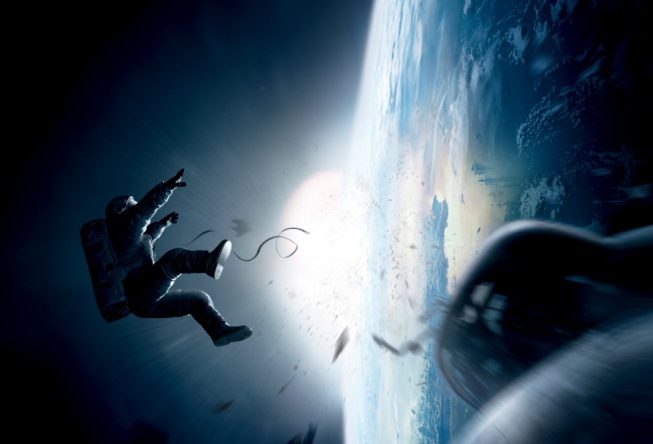 nobile con la risoluzione della grandinata di avversità a getto continuato com'è nelle corde della produzione hollywoodiana più commerciale, là dove l'approssimazione, l'inverosimiglianza di alcuni passaggi (ed evito di proposito di fare la lista della spesa per non smorzare in alcun modo le attese del legittimo diritto all'intrattenimento), finisce per intorbidare le chiare e fresche acque degli inizi, tanto intense e promettenti.
nobile con la risoluzione della grandinata di avversità a getto continuato com'è nelle corde della produzione hollywoodiana più commerciale, là dove l'approssimazione, l'inverosimiglianza di alcuni passaggi (ed evito di proposito di fare la lista della spesa per non smorzare in alcun modo le attese del legittimo diritto all'intrattenimento), finisce per intorbidare le chiare e fresche acque degli inizi, tanto intense e promettenti.
Così si apprezzano le idee di fondo della sindrome Kessler, ipotesi scientifica secondo la quale in certe particolari condizioni si innescherebbe una reazione a catena che nel film prende corpo con la pioggia di detriti su detriti; l'inedito sguardo degli inizi, prodigo di numerose soggettive partorite sull'onda di superfici riflettenti come la visiera del casco da astronauta; nonché le impegnative performances di Clooney e soprattutto di Bullock nella messa a fuoco dei rispettivi personaggi, non privi delle loro ferite personali. Ed ancora, mentre si riesce a promuovere pure la |
|
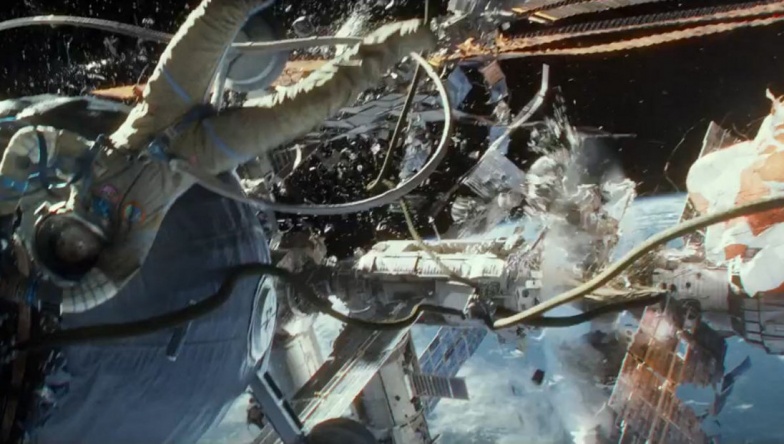 trovata con cui si materializza in carne ed ossa sul grande schermo il supporto emotivo, quel bisogno bruciante del sostegno psicologico necessario per attutire il rantolo soffocante di una paura derivata dal grado di solitudine più alto che ci si possa immaginare, ci si può sentire altresì in qualche modo traditi: talora dalla ridondante ironia ad oltranza e da uno humour ormai fuori tempo massimo, talaltra da alcuni tagli esasperati nel montaggio che tolgono il respiro necessario alla vita vera di una certa sequenza, e perfino dall'eccessiva esternazione di sentimenti profondi e nobili di per sé, nella seconda parte del film ridotti a mélo con buona partecipazione di brani musicali trionfalisticamente baroccheggianti in scalata libera sulla vetta dei decibel. Un vero peccato, perché Gravity poteva sfociare in un piccolo capolavoro, e le premesse c'erano tutte, invece andrà ad ingrassare le fila di un nuovo, ambizioso, indubbiamente suggestivo, intrattenimento nelle profonditÃ
trovata con cui si materializza in carne ed ossa sul grande schermo il supporto emotivo, quel bisogno bruciante del sostegno psicologico necessario per attutire il rantolo soffocante di una paura derivata dal grado di solitudine più alto che ci si possa immaginare, ci si può sentire altresì in qualche modo traditi: talora dalla ridondante ironia ad oltranza e da uno humour ormai fuori tempo massimo, talaltra da alcuni tagli esasperati nel montaggio che tolgono il respiro necessario alla vita vera di una certa sequenza, e perfino dall'eccessiva esternazione di sentimenti profondi e nobili di per sé, nella seconda parte del film ridotti a mélo con buona partecipazione di brani musicali trionfalisticamente baroccheggianti in scalata libera sulla vetta dei decibel. Un vero peccato, perché Gravity poteva sfociare in un piccolo capolavoro, e le premesse c'erano tutte, invece andrà ad ingrassare le fila di un nuovo, ambizioso, indubbiamente suggestivo, intrattenimento nelle profondità |
|
 dello spazio.
dello spazio. |
|
|
|
|
|
|
|
|
|
|
|
|
|
|
|
|
|
|
Secondo commento critico (a cura di JUSTIN CHANG, www.variety.com)
|
 About halfway through Alfonso Cuaronâs astonishing âGravity,â Sandra Bullock, playing a lost astronaut stranded 375 miles above Earth, seeks refuge in an abandoned spacecraft and curls into a floating fetal position, savoring a brief respite from her harrowing journey. Of the many sights to behold in this white-knuckle space odyssey, a work of great narrative simplicity and visual complexity, itâs this image that speaks most eloquently to Cuaronâs gifts as a filmmaker: Heâs the rare virtuoso capable of steering us through vividly imagined worlds and into deep recesses of human feeling. Suspending viewers alongside Bullock for a taut, transporting 91 minutes (with George Clooney in a sly supporting turn), the directorâs long-overdue follow-up to âChildren of Menâ is at once a nervy experiment in blockbuster minimalism and a film of robust movie-movie thrills, restoring a sense of wonder, terror and possibility to the bigscreen that should inspire awe among critics
About halfway through Alfonso Cuaronâs astonishing âGravity,â Sandra Bullock, playing a lost astronaut stranded 375 miles above Earth, seeks refuge in an abandoned spacecraft and curls into a floating fetal position, savoring a brief respite from her harrowing journey. Of the many sights to behold in this white-knuckle space odyssey, a work of great narrative simplicity and visual complexity, itâs this image that speaks most eloquently to Cuaronâs gifts as a filmmaker: Heâs the rare virtuoso capable of steering us through vividly imagined worlds and into deep recesses of human feeling. Suspending viewers alongside Bullock for a taut, transporting 91 minutes (with George Clooney in a sly supporting turn), the directorâs long-overdue follow-up to âChildren of Menâ is at once a nervy experiment in blockbuster minimalism and a film of robust movie-movie thrills, restoring a sense of wonder, terror and possibility to the bigscreen that should inspire awe among critics |
|
 and audiences worldwide.
and audiences worldwide.
Opening Oct. 4 Stateside following its Venice and Toronto premieres, the Warner Bros. release offers in abundance the sort of eye-popping, screen-filling spectacle that demands to be viewed in a theater. Not unlike earlier triumphs of 3D and vfx innovation such as âAvatarâ and âLife of Pi,â though conceived along less fantastical, more grimly realistic lines, âGravityâ is at once classical and cutting-edge in its showmanship, placing the most advanced digital filmmaking techniques in service of material that could hardly feel more accessible.
As scripted by Cuaron and his son Jonas, this tale of one womanâs grim expedition into the unknown is a nerve-shredding suspenser, a daring study in extreme isolation, and one of the most sophisticated and enveloping visions of space travel yet realized onscreen. It falls among that increasingly rare breed of popular entertainments capable of prompting genuine âHow did they do that?â reactions from even |
|
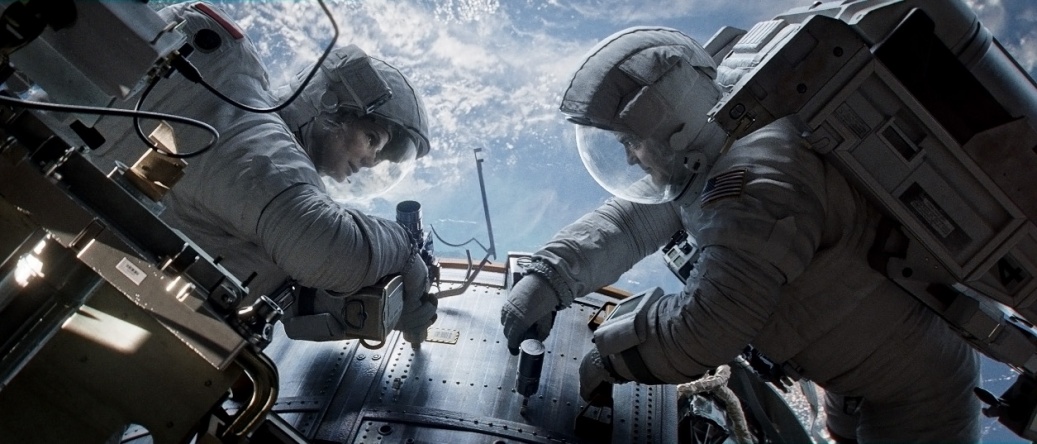 the most jaded viewers, even as its central premise is so simple and immediately gripping that one might just as readily ask, âWhy didnât anyone do it sooner?â
the most jaded viewers, even as its central premise is so simple and immediately gripping that one might just as readily ask, âWhy didnât anyone do it sooner?â
The answer to both questions is that Cuaron, in another remarkable collaboration with longtime cinematographer Emmanuel Lubezki and visual effects supervisor Tim Webber (âChildren of Menâ), has pushed the relevant technologies to their limits in order to tell this story with the sort of impeccable verisimilitude and spellbinding visual clarity it requires. The long, intricate tracking shots the three devised for the earlier film were a mere warm-up act for what they unleash here, as is clear from the stunningly choreographed opening sequence â an unbroken, roughly 13-minute long take that plunges us immediately into the deafening silence of space. Specifically, we are in the atmospheric layer known as the thermosphere, the Earthâs massive form looming large in the widescreen frame as an |
|
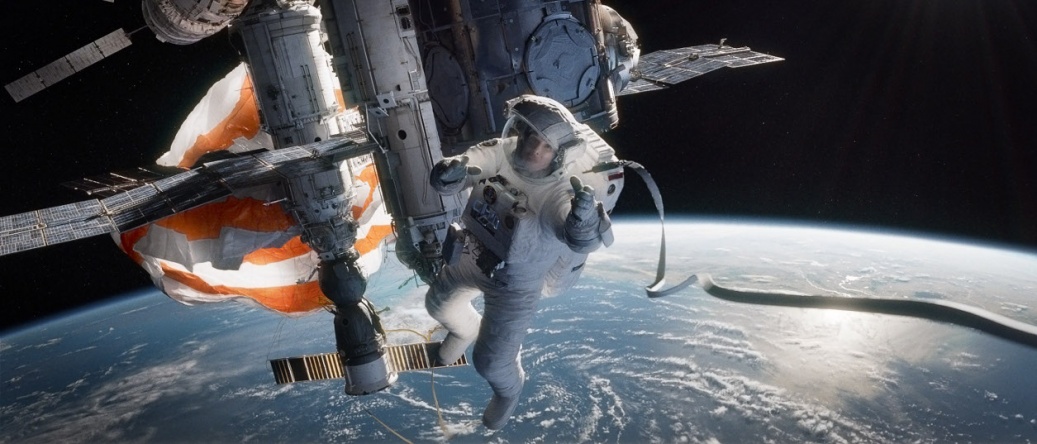 orbiting shuttle gradually cruises into focus.
orbiting shuttle gradually cruises into focus.
Three members of the crew have left the shuttle to help repair the Hubble telescope, though dramatically, the picture is concerned with only two of them: Matt Kowalsky (Clooney), a seasoned astronaut leading his final mission, and Dr. Ryan Stone (Bullock), a medical engineer on her first. The mood is relaxed initially, even humorous; radio music plays in the background as the astronauts exchange banter with mission control. Kowalsky, drifting lazily about in his harness, brags that heâs about to break the official record for longest spacewalk. The far less experienced Stone nervously tries to stay focused on her task, not the easiest thing to do for someone still adjusting to the woozy effects of zero gravity.
âHouston, I have a bad feeling about this mission,â Kowalsky quips early on. Yet all joking ceases when Houston suddenly reports that a cloud of debris, triggered by the |
|
 self-destruction of a nearby Russian satellite, is headed their way. The camera, having gracefully bobbed and weaved around the astronauts without a single cut so far, continues to observe with unblinking concentration as the ship is pelted with shrapnel, killing the third astronaut, causing widespread damage and severing all communications with Houston. Amid the chaos, Stone comes untethered and finds herself spinning, alone and helpless, in the vast emptiness of space, an experience the audience will soon share to a deeply unnerving degree.
self-destruction of a nearby Russian satellite, is headed their way. The camera, having gracefully bobbed and weaved around the astronauts without a single cut so far, continues to observe with unblinking concentration as the ship is pelted with shrapnel, killing the third astronaut, causing widespread damage and severing all communications with Houston. Amid the chaos, Stone comes untethered and finds herself spinning, alone and helpless, in the vast emptiness of space, an experience the audience will soon share to a deeply unnerving degree.
In one continuous shot, the film has not only introduced its central crisis â will Stone survive? â but also completely immersed us in the beauty and majesty of a dark, pitiless universe. While âGravityâ is hardly the first film to send characters into orbit, few have so powerfully and subjectively evoked the sensation of floating right there with them. As it glides nimbly around the action, the |
|
 camera induces a deeply pleasurable feeling of weightlessness (the film might just as well have been titled âDancing With the Starsâ) that can suddenly turn from exhilarating to terrifying, leaving us gasping for oxygen alongside the characters.
camera induces a deeply pleasurable feeling of weightlessness (the film might just as well have been titled âDancing With the Starsâ) that can suddenly turn from exhilarating to terrifying, leaving us gasping for oxygen alongside the characters.
The filmmakersâ technical command here is so precise that theyâre able to shift perspectives at will; more than once the camera zooms in tighter and tighter on Stone until it seems to enter her helmet, sharing her frightening view of the great, black expanse before her. Exactly what she sees and endures over the course of her journey would be unfair to reveal. Suffice to say the script modulates the tension expertly, deftly preying on the claustrophobic and the agoraphobic alike, and maintaining an unflagging sense of peril as it carefully throws Stone one lifeline
after another.
The most crucial of these lifelines turns out to be Kowalsky, who initially comes off as the filmâs |
|
 most obtrusive element, a glib smart-ass whoâs there to help Stone and the audience find their bearings, and to provide a measure of comic relief. Yet while Clooneyâs flippant leading-man charm may seem incongruous in this context at first, his tough-and-tender rapport with Bullock pulses with understated feeling, never more so than when the two astronauts are tethered together, trying to make their way to safety. Clooney gets one particularly audacious scene that perhaps only a star of his stature could have managed, pulling the viewer through various states of shock, disbelief and finally bittersweet understanding; itâs a haunting moment that firmly ties âGravity,â for all its uncompromising realism, to the soul of classic Hollywood.
most obtrusive element, a glib smart-ass whoâs there to help Stone and the audience find their bearings, and to provide a measure of comic relief. Yet while Clooneyâs flippant leading-man charm may seem incongruous in this context at first, his tough-and-tender rapport with Bullock pulses with understated feeling, never more so than when the two astronauts are tethered together, trying to make their way to safety. Clooney gets one particularly audacious scene that perhaps only a star of his stature could have managed, pulling the viewer through various states of shock, disbelief and finally bittersweet understanding; itâs a haunting moment that firmly ties âGravity,â for all its uncompromising realism, to the soul of classic Hollywood.
There are glimmers of artifice, too, in the scriptâs conception of Stone, who turns out to have a tragedy in her past, an unhealed wound that feels rather needlessly engineered to provide the viewer with a |
|
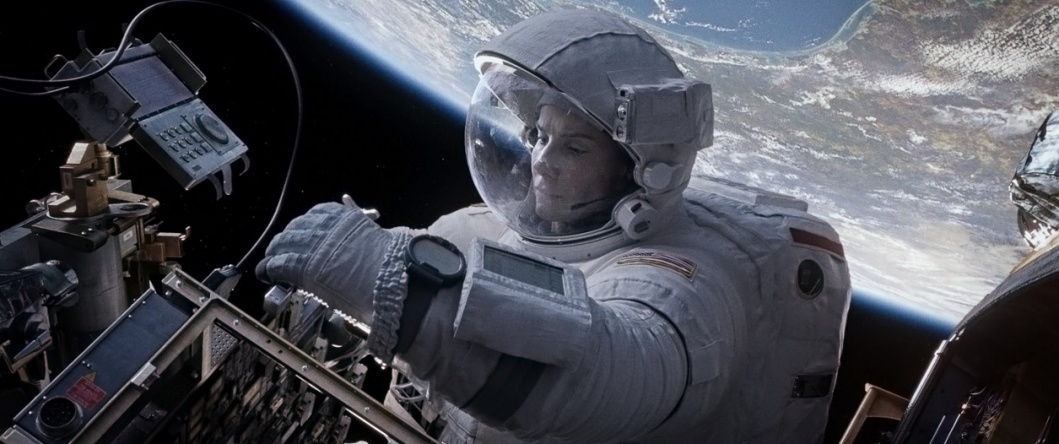 psychological entry point, as well as a deeper stake in her survival. Itâs the one on-the-nose element in a screenplay that, given its rigorous intelligence in all other departments, might have done well to trust the audience to stay invested in Stoneâs journey without the benefit of an emotional hook. (Providing a fascinating contrast is J.C. Chandorâs upcoming stranded-at-sea thriller âAll Is Lost,â in some ways a purer, more radical storytelling experiment in which words, motivations and explanations have been almost completely expunged.)
psychological entry point, as well as a deeper stake in her survival. Itâs the one on-the-nose element in a screenplay that, given its rigorous intelligence in all other departments, might have done well to trust the audience to stay invested in Stoneâs journey without the benefit of an emotional hook. (Providing a fascinating contrast is J.C. Chandorâs upcoming stranded-at-sea thriller âAll Is Lost,â in some ways a purer, more radical storytelling experiment in which words, motivations and explanations have been almost completely expunged.)
Nonetheless, Bullock inhabits the role with grave dignity and hints at Stoneâs past scars with sensitivity and tact, and she holds the screen effortlessly once âGravityâ becomes a veritable one-woman show. In a performance that imposes extraordinary physical demands, the actress remains fully present emotionally, projecting a very appealing combo of vulnerability, intelligence and determination that not only wins us over immediately, but sustains attention all the way |
|
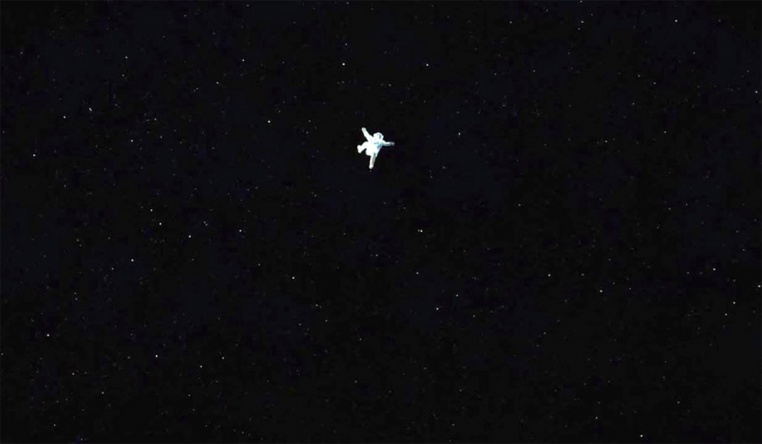 through the cathartic closing reels.
through the cathartic closing reels.
The outstanding post-production 3D conversion enhances our sense of immersion in this foreign environment at every turn. Images of outer space give new meaning to the term âdeep focus,â while the scenes set in enclosed environs provide a pleasing visual balance and contrast, with floating objects supplying a natural depth of field. As visual an experience as the film is, it would be far less effective without the exceptional sound work by production mixer Chris Munro and sound designer Glenn Freemantle, which makes especially potent use of silence in accordance with the laws of outer-space physics. Helping to vary the soundscape is Steven Priceâs richly ominous score, playing like an extension of the jolts and tremors that accompany the action onscreen.
All in all, it would be impossible to overestimate the difficulty of what Cuaron and his top-of-the-line crew have pulled off, or to guess at the |
|
 staggering number of decisions that were made regarding specifics of camera placement and movement; the motion-control robots that were used on the actors to plausibly simulate zero-gravity conditions; the marvelous scope and detail of Andy Nicholsonâs production design; and the meticulous integration of visual effects, all-digital backgrounds, traditional lighting schemes and other live-action lensing techniques. But perhaps the boldest risk of all was the decision to combine these elements in a manner that would hold up under the prolonged scrutiny of the camera, in single-shot sequences of such breathtaking duration and coherence. Somewhere, one imagines, the spirits of Stanley Kubrick and Max Ophuls are looking down in admiration.
staggering number of decisions that were made regarding specifics of camera placement and movement; the motion-control robots that were used on the actors to plausibly simulate zero-gravity conditions; the marvelous scope and detail of Andy Nicholsonâs production design; and the meticulous integration of visual effects, all-digital backgrounds, traditional lighting schemes and other live-action lensing techniques. But perhaps the boldest risk of all was the decision to combine these elements in a manner that would hold up under the prolonged scrutiny of the camera, in single-shot sequences of such breathtaking duration and coherence. Somewhere, one imagines, the spirits of Stanley Kubrick and Max Ophuls are looking down in admiration. |
Bibliografia:
Nota: Si ringraziano Warner Bros. Pictures Italia e Silvia Saba (SwService)
Pressbook:
 PRESSBOOK COMPLETO in ITALIANO di GRAVITY
PRESSBOOK COMPLETO in ITALIANO di GRAVITY
 ENGLISH PRESSBOOK of GRAVITY
ENGLISH PRESSBOOK of GRAVITY
Links:
• 70. Mostra Internazionale dâArte Cinematografica (28 agosto â 7 settembre 2013) - QUALE PROGRAMMA! LA PRESENTAZIONE UFFICIALE (Servizio a cura dell'inviata ELISABETTA VILLAGGIO) (CineSpigolature)
• INTERSTELLAR: FORSE CHE SI, FORSE CHE NO! (A cura di ROSS DI GIOIA) (CineSpigolature)
• I âRECUPERATIâ di âCelluloidPortraitsâ - GRAVITY di ALFONSO CUARON - INTERVISTA all'attore GEORGE CLOONEY (Interviste)
• 70. Mostra Internazionale dâArte Cinematografica (28 agosto â 7 settembre 2013) - 'GRAVITY' DI ALFONSO CUARÃN CON SANDRA BULLOCK E GEORGE CLOONEY Ã IL FILM DI APERTURA (Speciali)
• Dalla 70. Mostra del Cinema di Venezia alla sala cinematografica - 'GRAVITY' di ALFONSO CUARON con GEORGE CLOONEY e SANDRA BULLOCK (Anteprime)
Altri Links:
- Sito ufficiale
- Pagina Facebook
Twitter: #Gravity
Galleria Fotografica:
Galleria Video:
 Gravity - trailer 2
Gravity - trailer 2
 Gravity - trailer
Gravity - trailer
 Gravity - trailer (versione originale)
Gravity - trailer (versione originale)
 Gravity - spot 'Nessuna via di fuga'
Gravity - spot 'Nessuna via di fuga'
 Gravity - spot 'Non mollare ora'
Gravity - spot 'Non mollare ora'
 Gravity - spot '372 miglia dalla terra'
Gravity - spot '372 miglia dalla terra'
 Gravity - clip 1
Gravity - clip 1
 Gravity - clip 2
Gravity - clip 2
 Gravity - clip 3
Gravity - clip 3
Fatal error: Uncaught Error: Call to undefined function str_starts_with() in /web/htdocs/www.celluloidportraits.com/home/util.php:223
Stack trace:
#0 /web/htdocs/www.celluloidportraits.com/home/schedamovie.php(775): makeLinkVideo()
#1 {main}
thrown in /web/htdocs/www.celluloidportraits.com/home/util.php on line 223
|


